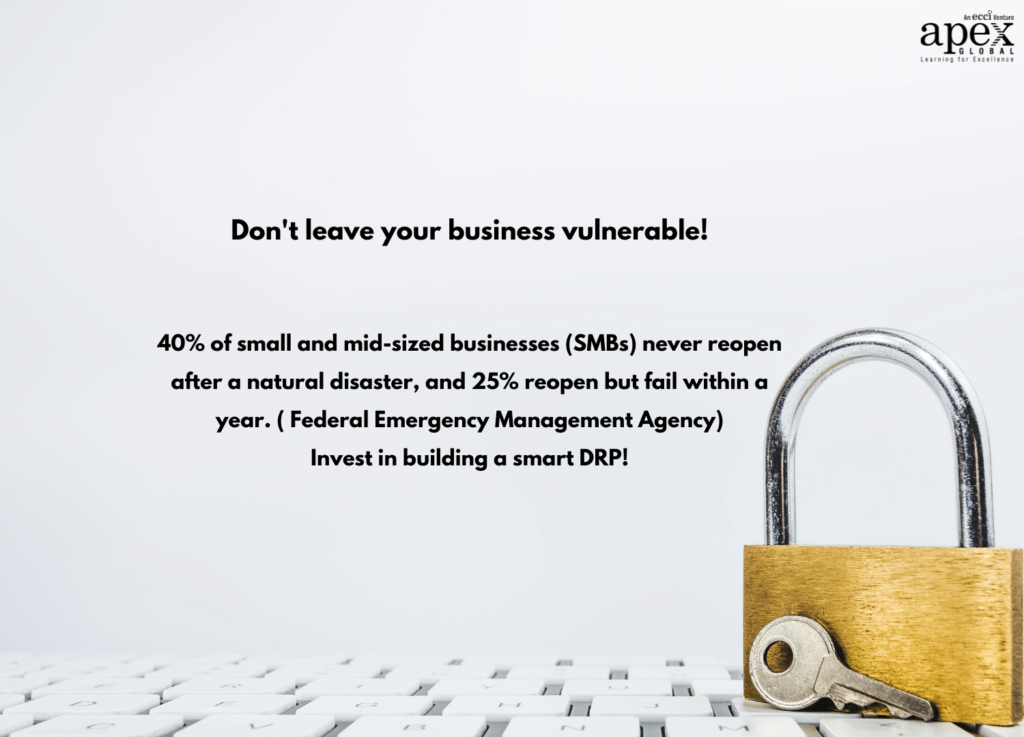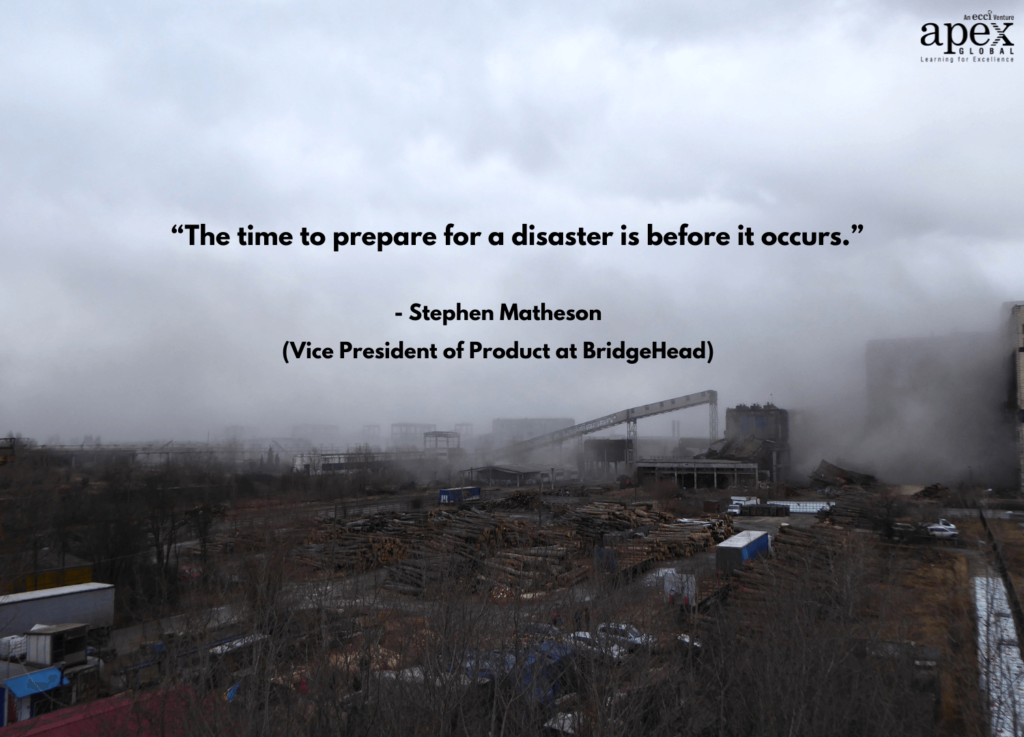A well-crafted disaster recovery plan (DRP) can be the difference between overcoming a crisis and succumbing to it. In this blog post, we will explore five real-life examples of successful disaster recovery plans, analyze what makes them tick, and identify the ten essential elements that every smart DRP should have in common.
Disasters happen. It’s not a matter of if, but when. And in the world of business, even an hour of downtime can mean significant losses. That’s where disaster recovery plans come into the picture, saving the day (and your business).
You already understand the importance of having a workable disaster recovery plan in place. However, not all disaster recovery plans are created equal.

What keeps a smart disaster recovery plan running smoothly? To break it down, it should encompass three key components-
- It should be easy to understand
- Always comprehensive
- Proactive with an immediate response strategy
The plan should not only cover the critical IT systems but also account for the business operations and other non-IT systems. Most importantly, it should be regularly tested and updated to account for new risks and emerging technologies.
In short, disaster recovery planning is not something to take lightly. Don’t wait for disaster to strike before thinking about your response. A solid plan should be at the core of any well-run organization.
What you'll find in this article [hide]
- 1 Real-life examples: learning from success stories
- 2 Example 1: Amazon’s ‘resilience engineering’ approach
- 3 Example 2: Target’s multi-layered response plan
- 4 Example 3: Salesforce’s high-availability engineering system
- 5 Example 4: Hurricane Katrina recovery efforts-community support and collaboration with local businesses
- 6 Example 5: UTMB Health’s emergency operations plan
- 7 What makes a disaster recovery plan tick?
- 8 10 essentials every smart disaster recovery plan has in common
- 8.1 1. Clear and detailed communication plan:
- 8.2 2. Documented recovery procedures:
- 8.3 3. Regular data backups and offsite storage:
- 8.4 4. Redundant infrastructure and systems:
- 8.5 5. Well-defined roles and responsibilities:
- 8.6 6. Employee training and awareness programs:
- 8.7 7. Continuous monitoring and alert systems:
- 8.8 8. Incident response and escalation procedures:
- 8.9 9. Regular testing and simulation exercises:
- 8.10 10. Periodic plan review and updates:
- 9 Final thoughts
Real-life examples: learning from success stories
What makes a successful disaster recovery plan and how to recognize when it’s time to ask for help?
First and foremost, a great plan should include backups of all essential data and the ability to restore it quickly. But if you find yourself struggling with identifying critical assets or putting together a solid plan, it might be time to bring in an expert.
Remember, there’s no shame in asking for help – especially when it comes to protecting your organization’s future.
What are your immediate options?
- Opt for professional training to learn about critical elements and customize your disaster recovery approach: professional courses can help prepare your team for the very worst. Using case scenarios and expert course design can professional trainers institute a risk-based outlook on how you should view disaster planning and business resilience for your organization. APEX Global Learning has a comprehensive course on disaster recovery and emergency preparedness. Check out the Disaster Recovery Practitioner course to know more.
- By reviewing real-life examples of successful Disaster recovery plans implemented by other organizations -Why follow real-life examples? Because they provide insight into what works, and what doesn’t, in the face of disasters. Learning from the experiences of others can help you tailor your own plan to address the specific challenges of your industry and location.
Let’s check out the key factors and the essential elements shared by smart DRPs, to bolster your own disaster preparedness.

Example 1: Amazon’s ‘resilience engineering’ approach
Amazon invests heavily in building systems that are resilient to any unforeseen circumstances. This means that instead of scrambling to fix things once the damage is done, they have proactive measures in place that reduce downtime, save costs, and increase customer satisfaction.
Recovery strategy employed
The resilient engineering approach is part of Amazon’s AWS Well-Architected Framework, and it focuses on creating resilient workloads.
Resilient workloads are able to recover quickly and efficiently when faced with stress, attacks, or component failures.
Key takeaways and lessons learned
The key to this approach is defining a Recovery Time Objective (RTO), which sets the allowable amount of time for recovery. This concept is also known as Recovery Oriented Computing and is an important aspect of modern technology development.
Example 2: Target’s multi-layered response plan
Target has a multi-layered response plan in place for times of crisis or humanitarian need.
Recovery strategy employed
Target has multiple teams working together, each with defined roles and responsibilities to respond to emergencies or crises. The company has systems in place to monitor and detect potential issues early, enabling them to respond quickly. Their global supply chain can move quickly to support their stores and guests, ensuring they have what they need during times of crisis.
Key takeaways and lessons learned
The multi-layered response plan includes measures to ensure the safety and security of their employees, customers, and properties.
Example 3: Salesforce’s high-availability engineering system
Salesforce has developed an industry-standard DRP that ensures high-availability engineering principles are maintained at all times.
Recovery strategy employed
The plan is constantly monitored and measured against strict regulatory and governance requirements.
It is an essential part of Salesforce’s production environment, making it an important aspect of any changes or additions made to the platform.
Key takeaways and lessons learned
The key to this approach is defining a Recovery Time Objective (RTO), which sets the allowable amount of time for recovery. This concept is also known as Recovery Oriented Computing and is an important aspect of modern technology development.
Example 4: Hurricane Katrina recovery efforts-community support and collaboration with local businesses
Looking back at Hurricane Katrina, local organizations showed how important it is to take control of your own response in the aftermath of disasters.
Recovery strategy employed
Organizations that had existing social networks were better able to mobilize resources and support after the hurricane.
Sustainable programs with community-based organizations can be key in facilitating prompt recovery. Building these partnerships before disaster strikes can make all the difference.
Key takeaways and lessons learned
Utilize government programs, such as the Community Development Block Grant Disaster Recovery program, to rebuild businesses and other infrastructure.
Example 5: UTMB Health’s emergency operations plan
When it comes to crisis communication management, having a solid plan in place can be the difference between chaos and order. UTMB Health’s emergency operations plan involves all staff and volunteers, ensuring that everyone is on the same page during emergency or disaster incidents.
Recovery strategy employed
The recovery strategy is built to prioritize that critical systems and infrastructure are protected to ensure that necessary services can still be provided. Alternate treatment areas or locations are identified in case the primary location is no longer feasible. Developing a crisis response team and providing regular training and drills to prepare for emergencies.
Key takeaways and lessons learned
The key to this approach is understanding the role of communication in crisis management and how it can be utilized to ensure effective coordination and response efforts.
.
What makes a disaster recovery plan tick?
What makes a disaster recovery plan truly effective? In our opinion, it’s all about having a smart DRP with a common quality standard at the core. That’s what sets the best DRPs apart from the rest. A well-designed DRP not only helps your business recover from unforeseen events but also provides the confidence and security you need to face any disaster head-on.
So, if you’re currently working on your disaster recovery plan or need to revamp your existing one, make sure it has this vital quality standard in place.
Smart DRP quality standards should include:
- Identifies potential disasters and their impacts on your business
- Ensures backups are in place for mission-critical systems and data to minimize downtime
- Regularly tested to identify any weaknesses and improved
- Consider Unique USPs to go beyond the norm and offer customized attention points, like access to mobile command centers or priority emergency response.
- Partners with disaster recovery and business continuity experts who can help create and implement an effective plan.
- Records all key processes and procedures in an accessible format for quick reference during emergencies
- Prioritizes business continuity ensuring your business can continue operations with minimal impact

10 essentials every smart disaster recovery plan has in common
A Disaster Recovery Plan saves time and money. Time is money, and being down for even a day can hurt your bottom line. A plan ensures you get back up and running quickly. Learn and improve from past disasters. After a disaster, evaluate your plan and identify areas for improvement. This will help you be even better prepared in the future.
Don’t wait until it’s too late. Check out the 10 essentials that are common for all smart DRPs.
1. Clear and detailed communication plan:
A smart disaster recovery plan includes a communication strategy that clearly defines how the information will be shared during and after a disaster. This plan outlines the methods of communication, the individuals or teams responsible for communication, and the hierarchy of information dissemination. For example, a communication plan may specify that in the event of a disaster, a designated spokesperson will provide regular updates to employees, customers, and the media through various channels such as email, social media, and press releases.
2. Documented recovery procedures:
A disaster recovery plan should have well-documented procedures outlining the steps to be taken to restore operations after a disaster. These procedures provide a clear roadmap for recovery efforts and ensure consistency and efficiency. For instance, a recovery procedure might include instructions on how to restore data from backups, rebuild servers, and reestablish network connectivity.
3. Regular data backups and offsite storage:
A crucial aspect of any smart disaster recovery plan is the regular backup of critical data and storing it offsite. This ensures that even if the primary data center is damaged or destroyed, data can be recovered and operations can be resumed. For example, a company might schedule daily backups of its databases and store them in a secure offsite location or utilize cloud-based backup services.
4. Redundant infrastructure and systems:
Smart disaster recovery plans incorporate redundancy in infrastructure and systems to minimize downtime and ensure business continuity. This may involve deploying backup servers, network equipment, and power sources to create redundant systems. For instance, a company might have duplicate servers in geographically diverse locations, so if one server fails, the other can seamlessly take over.
5. Well-defined roles and responsibilities:
A disaster recovery plan clearly assigns roles and responsibilities to individuals or teams involved in the recovery process. This ensures that everyone knows their tasks and can act quickly and efficiently. For example, roles may include a disaster recovery coordinator, backup and restore team, and communication team, each with their specific responsibilities clearly defined.
6. Employee training and awareness programs:
It is important for employees to be trained and aware of their roles and responsibilities during a disaster. Training programs can include educating employees on how to respond to different types of disasters, how to access and use backup systems, and how to effectively communicate during recovery efforts. For instance, employees may participate in regular drills and training sessions to familiarize themselves with the disaster recovery plan.
7. Continuous monitoring and alert systems:
A smart disaster recovery plan includes continuous monitoring of critical systems and infrastructure. This involves implementing monitoring tools and alert systems that can detect potential issues or anomalies, allowing proactive intervention before a disaster occurs. For example, a company might use network monitoring software to track system performance, security breaches, or unusual patterns that could indicate a potential threat.
8. Incident response and escalation procedures:
In the event of a disaster, a well-defined incident response plan is essential. This plan outlines the steps to be taken immediately after an incident is detected, including who should be notified, how to assess the severity of the situation, and how to escalate the response if needed. For example, an incident response plan might include a protocol for reporting a cyberattack to the IT security team, who will then initiate a coordinated response.
9. Regular testing and simulation exercises:
A smart disaster recovery plan includes regular testing and simulation exercises to ensure its effectiveness. These exercises simulate various disaster scenarios to identify weaknesses, validate recovery procedures, and train personnel. For example, a company might conduct a tabletop exercise where participants simulate a specific disaster and discuss how they would respond, allowing them to identify gaps or areas for improvement.
10. Periodic plan review and updates:
Disaster recovery plans should be periodically reviewed and updated to reflect changes in technology, infrastructure, or business operations. This ensures that the plan remains relevant and effective over time. For instance, as a company grows and expands its operations, the disaster recovery plan may need to be revised to accommodate new systems, additional locations, or increased data volumes.
Final thoughts
Are you prepared for the worst? Here are some final thoughts on creating an effective disaster recovery plan. Having a disaster recovery plan is not optional anymore. How will your business continue to operate during and after a disaster? This means identifying potential threats and having measures in place to minimize damage. It’s important to involve all stakeholders in the planning process. Analyze your plan against real-life examples of disasters to identify any gaps or weaknesses. Security measures should be an integral part of your plan. Don’t forget to protect your data and physical assets. Finally, always have contingency plans in place for alternate work locations or remote work options if necessary. Flexibility is key!


